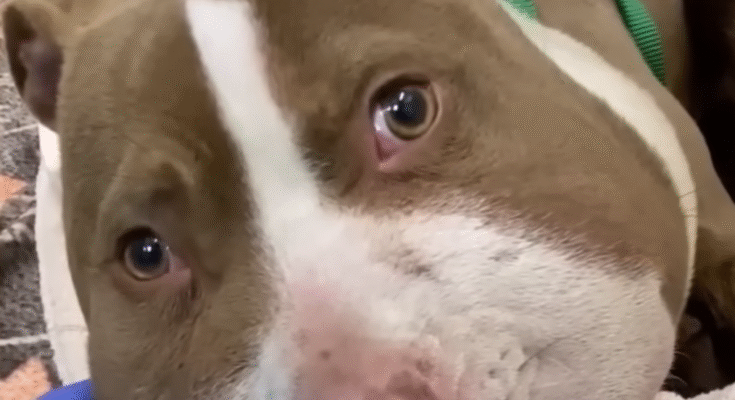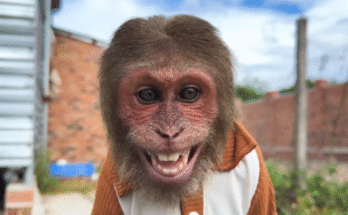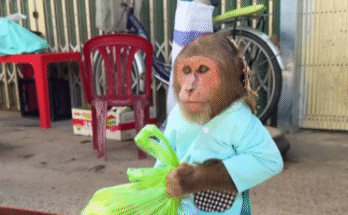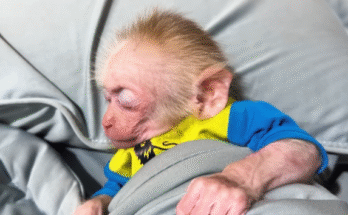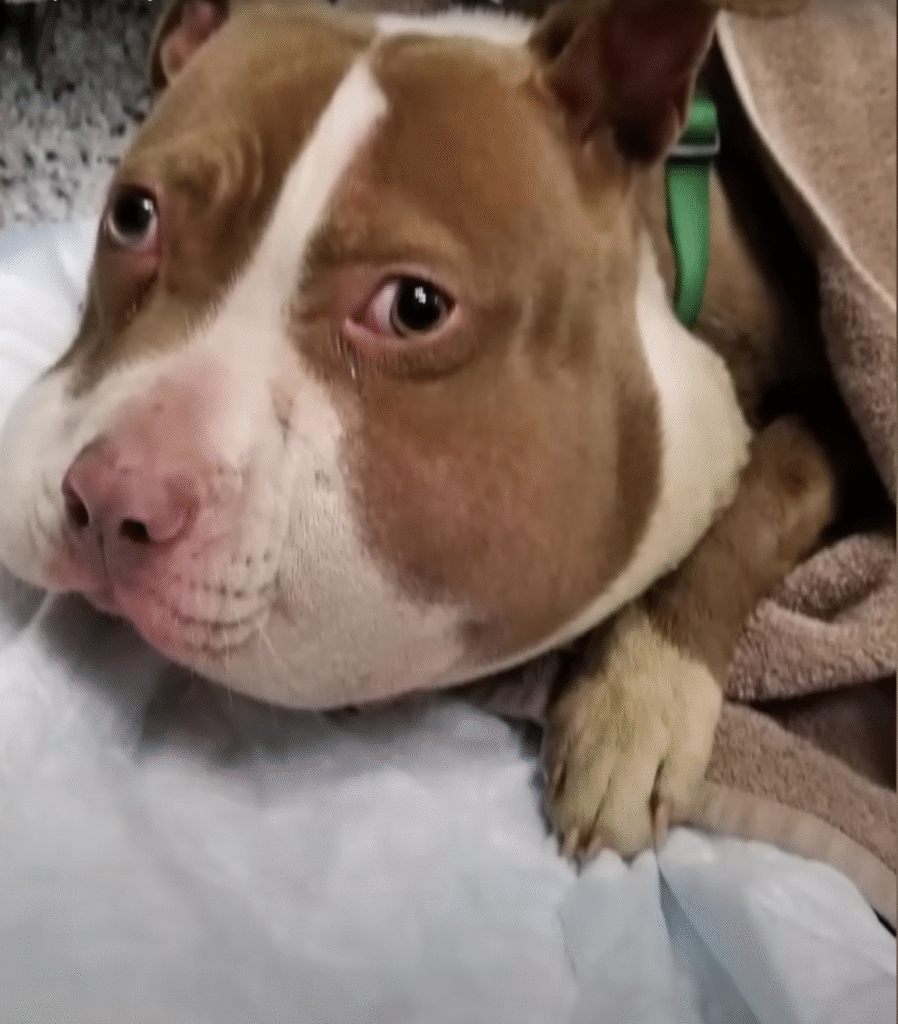
The morning was quiet in the small neighborhood, the kind of quiet that comes before the day fully wakes up. Sunlight spilled across the rows of houses, casting soft shadows on porches and driveways. Birds chirped in the distance, and the faint sound of a television drifted from a window somewhere.
Then came the knocking.
It wasn’t the sound of a fist on wood. It was softer, almost frantic — the sound of claws scratching against a door. At first, no one noticed. But as it continued, desperate and uneven, one of the residents, an elderly woman named Dara, put down her coffee and walked to the front window.
What she saw made her heart stop.
On her doorstep stood a dog — or what was left of one. Her fur was matted with dirt and blood, her eyes wide and glassy with pain. She was trembling so hard her legs barely held her up. She wasn’t barking or whining; she couldn’t. Around her neck was a thick rope, tightly wound and cutting deep into her skin. It had been there so long it had begun to fuse into her flesh, leaving a raw, festering wound.
The dog raised a weak paw, scratching at the door again as if knocking. Her chest rose and fell with short, shallow breaths. Her mouth opened soundlessly. She wanted to bark, to cry out, but no sound came. Only a faint wheeze.
“Oh, my God,” Dara whispered, opening the door. The smell hit her first — infection, sweat, and fear. She knelt down slowly, extending her hands. “It’s okay, sweetheart. You’re safe now.”
The dog flinched but didn’t run. She couldn’t. Her eyes met Dara’s, and in them was a plea so human it felt like a punch to the chest: Please help me.
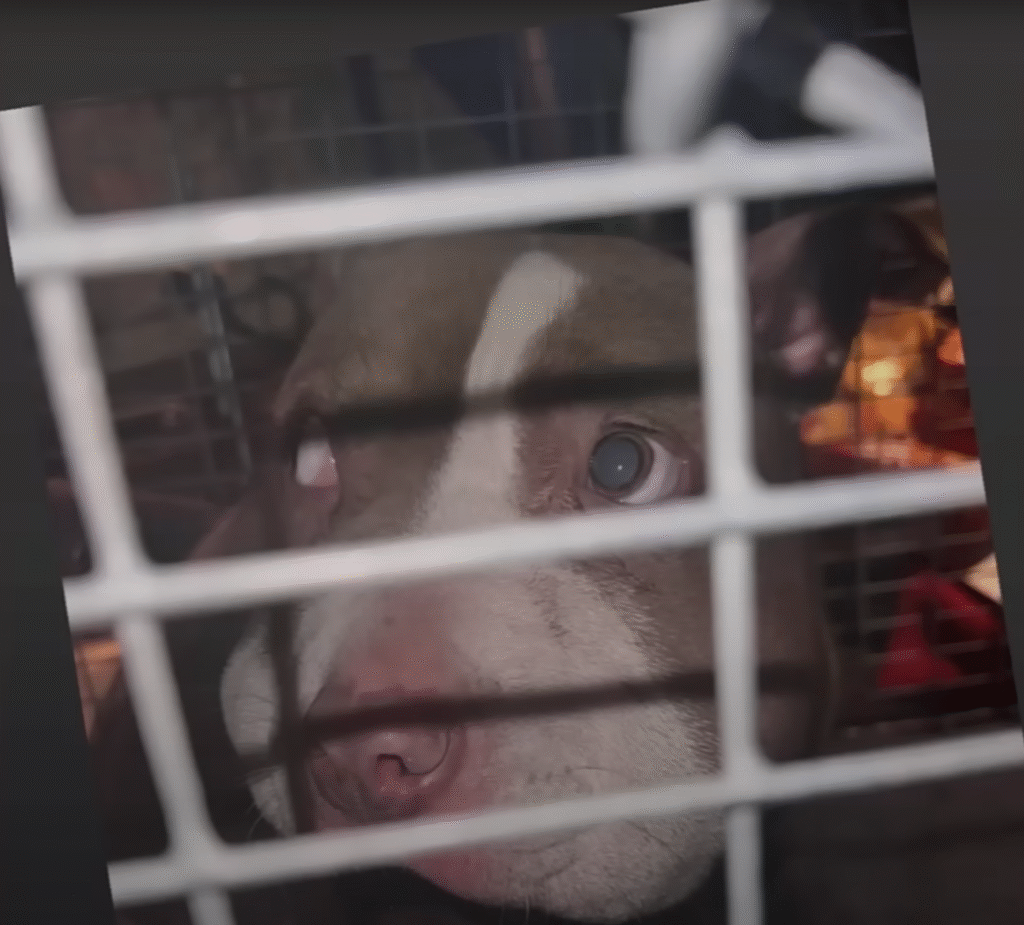
Dara moved quickly, grabbing a towel and some scissors from her kitchen. She returned to find the dog collapsed on her porch, her body shaking. The rope was old and frayed, crusted with dirt and dried blood. It looked like someone had tied it around her neck when she was a puppy, never loosening it as she grew.
“Oh, baby…” Dara murmured. “Who did this to you?”
She gently placed the towel over the dog’s body, speaking softly to keep her calm. With trembling hands, she began to cut away at the rope. It wasn’t easy — the fibers were tough, and parts of it had embedded so deep into the wound that it was like trying to cut through skin itself. The dog whimpered faintly, her body tensing with every snip, but she didn’t pull away.
After what felt like forever, the last strand of rope came free. Dara gasped at the sight of the wound underneath — a deep, infected gash that circled the dog’s neck entirely, oozing blood and pus.
She needed a vet immediately.
With as much care as she could muster, Dara lifted the dog into her car. She weighed almost nothing; years of neglect had stripped her down to skin and bone. Dara wrapped her in the towel and whispered, “Hang on, sweetheart. Just a little longer.”
The drive to the nearest animal hospital felt endless. The dog lay on the seat, her head resting weakly on Dara’s lap. Every now and then she tried to lift her eyes, as if to check that she wasn’t being abandoned again.
When they arrived, the staff rushed her into the emergency room. They asked Dara what happened, but she could only shake her head. “I just found her like that. She came to my door.”
In the sterile light of the clinic, the vet and his team worked quickly. They cleaned the wound, gave her antibiotics, and started IV fluids. They shaved the fur around her neck to better treat the gash, revealing just how severe the damage was.
“She’s been tied up for a very long time,” the vet said grimly. “The rope cut into her as she grew. She’s lucky she’s even alive.”
“Will she make it?” Dara asked, her voice breaking.
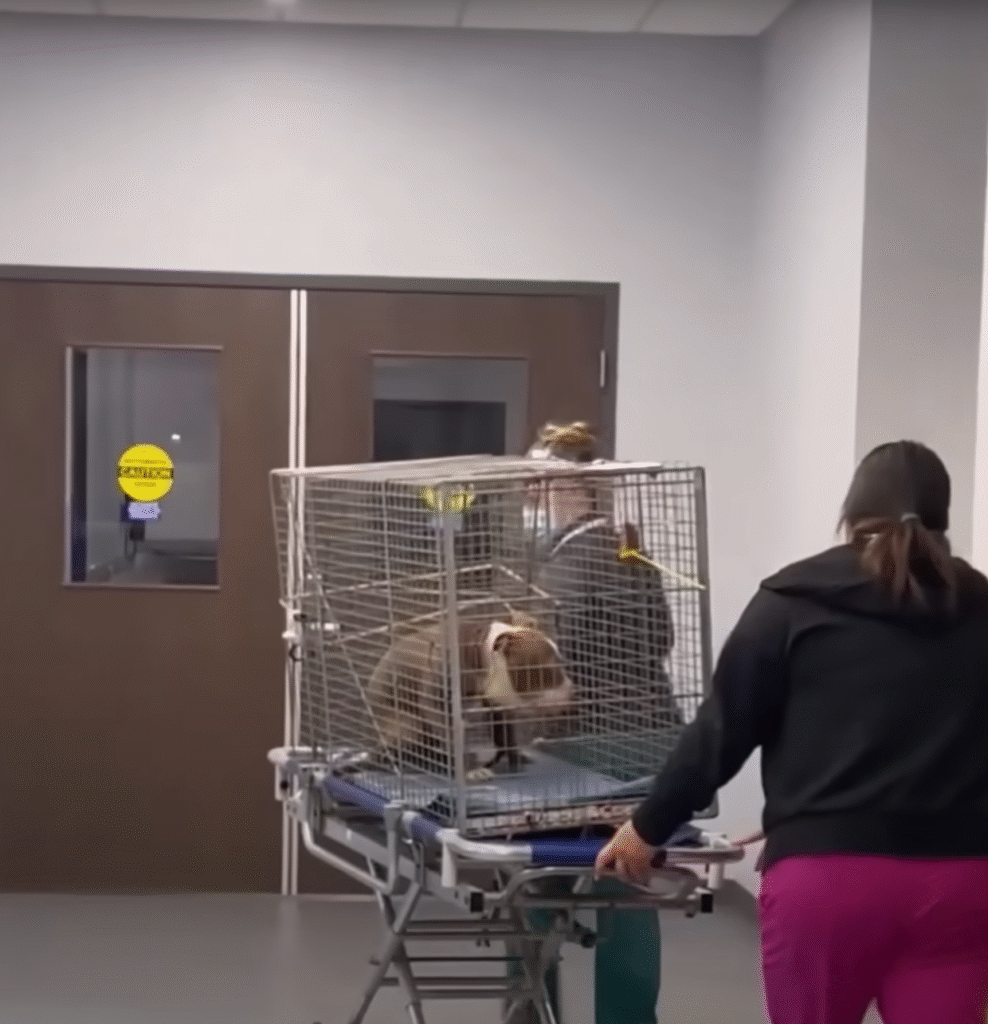
The vet hesitated. “She’s malnourished and weak. But she’s fighting. That’s a good sign.”
Over the next few days, Dara visited the clinic constantly. She learned the dog was about two years old — still young, but aged beyond her time by suffering. They named her Hope, because that’s what had brought her to Dara’s door.
Hope’s recovery was slow. She spent the first days barely moving, too exhausted to lift her head. But even then, her eyes would follow Dara when she entered the room, and her tail gave the faintest wag whenever she heard her voice.
By the end of the first week, Hope was eating small meals again. Her breathing improved. She could finally make small sounds — soft whimpers at first, then faint barks that cracked like a whisper.
“She’s getting her voice back,” the vet smiled one afternoon.
Dara reached out and stroked Hope’s fur gently. “You’re safe now,” she whispered. “No more ropes. No more pain.”
As Hope healed, her true personality began to emerge. She was gentle, almost shy, but incredibly affectionate. Whenever Dara visited, she would press her head against Dara’s chest and close her eyes, as if soaking in the warmth she had been denied all her life.
The wound around her neck took months to fully heal. Even then, a deep scar remained — a permanent reminder of what she had endured. But it didn’t define her anymore. She learned to walk on a leash without fear, to sleep without trembling, to eat without looking over her shoulder.
Dara decided she couldn’t let Hope go. She officially adopted her, bringing her home to the same porch where she had first appeared, broken and silent. This time, she walked through the door not as a stray, but as family.
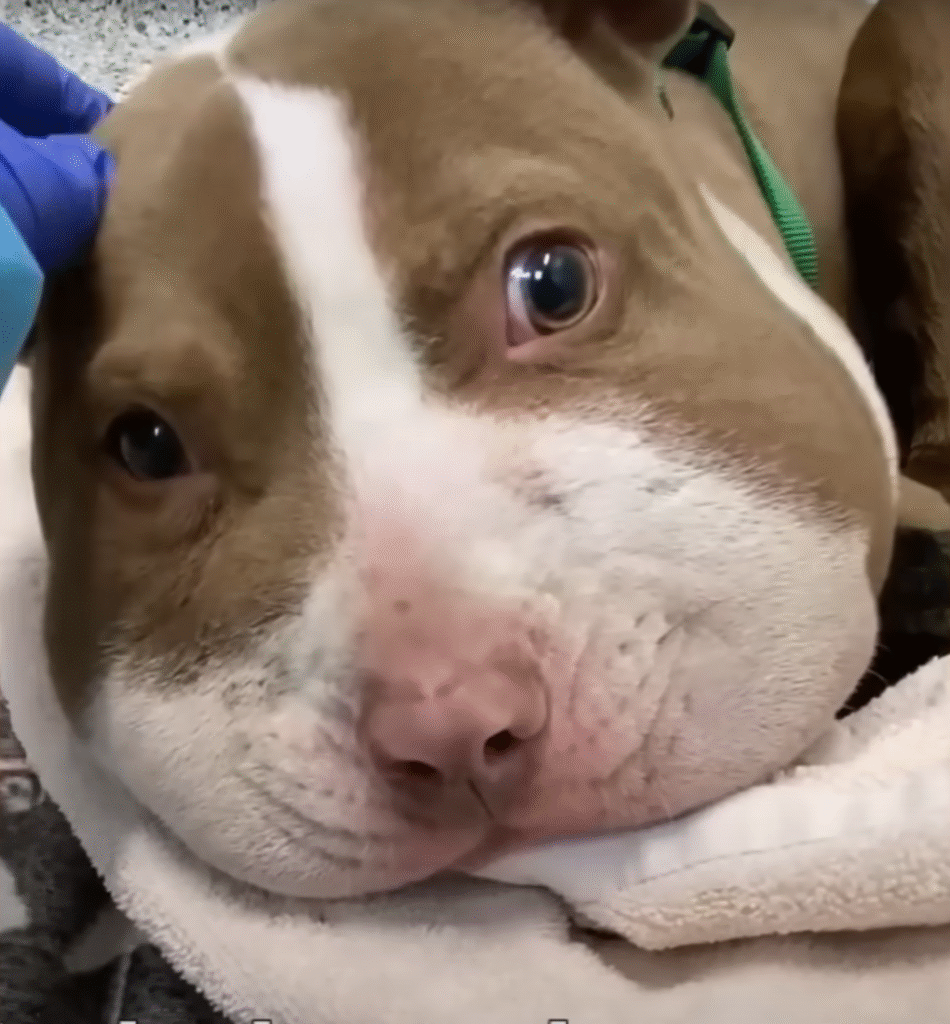
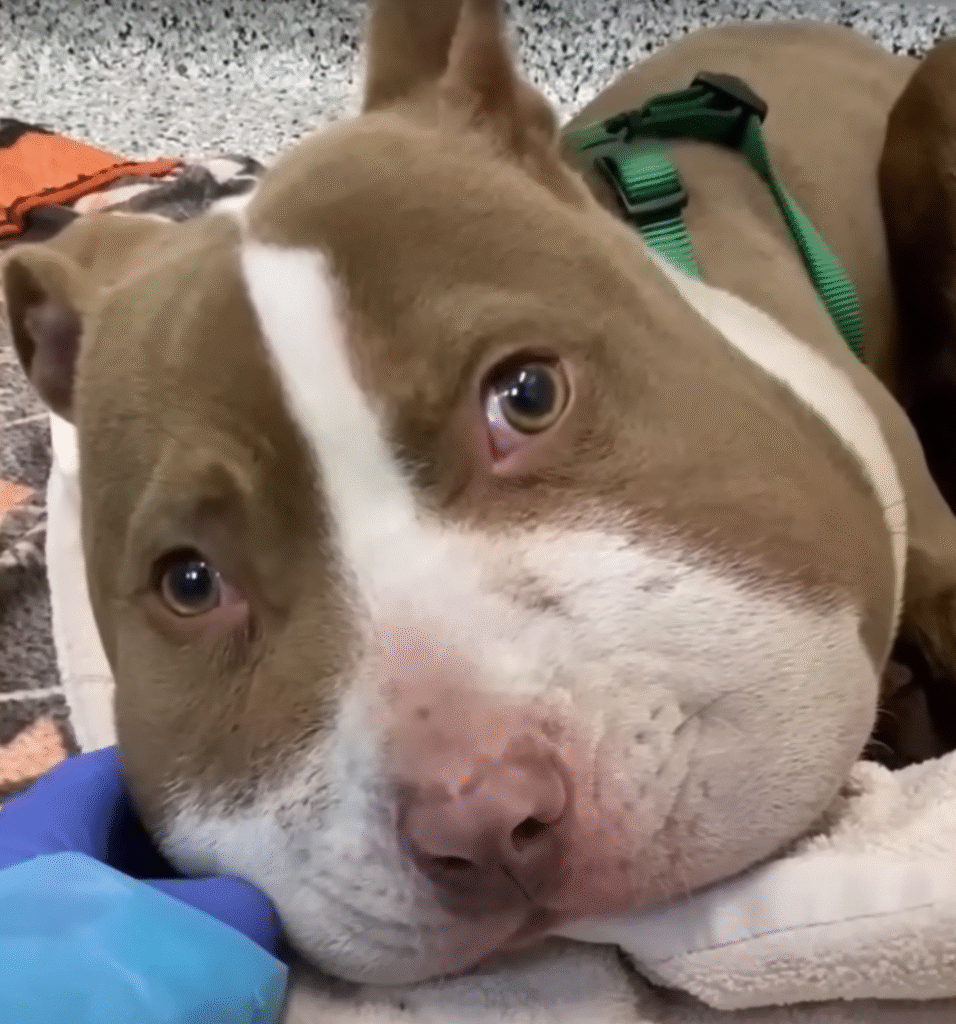
Life for Hope slowly transformed. She had a soft bed by the window, a yard to explore, toys to chew, and bowls that were always full. But what she loved most wasn’t the food or the toys — it was the touch. The gentle hands that stroked her head, the quiet voice that told her she was loved.
At night, she would curl up at Dara’s feet, sighing deeply as if releasing years of pain. Sometimes, she would still wake up from nightmares, whimpering softly. Dara would kneel beside her, stroke her scarred neck, and whisper, “You’re safe. I’m here.”
And Hope would settle again, her breathing evening out.
Months passed, and Hope blossomed into a healthy, happy dog. Her fur grew shiny, her eyes bright. She learned to bark freely — a strong, joyful sound that echoed through the yard. Neighbors who had once been startled by her sudden arrival now smiled when they saw her wagging her tail on walks.
People would often ask Dara about Hope’s scar. And every time, Dara would tell them the story — not to dwell on the cruelty she had endured, but to show what resilience and compassion can do.
“She came to my door, even when she could barely breathe,” Dara would say. “She asked for help the only way she knew how. And she didn’t give up.”
Hope’s story spread online after Dara shared her photos on social media. Messages poured in from strangers moved by her journey. Some said they were inspired to volunteer at shelters. Others said they had adopted rescues of their own. Hope had become a quiet symbol of survival — proof that even after the deepest wounds, healing was possible.
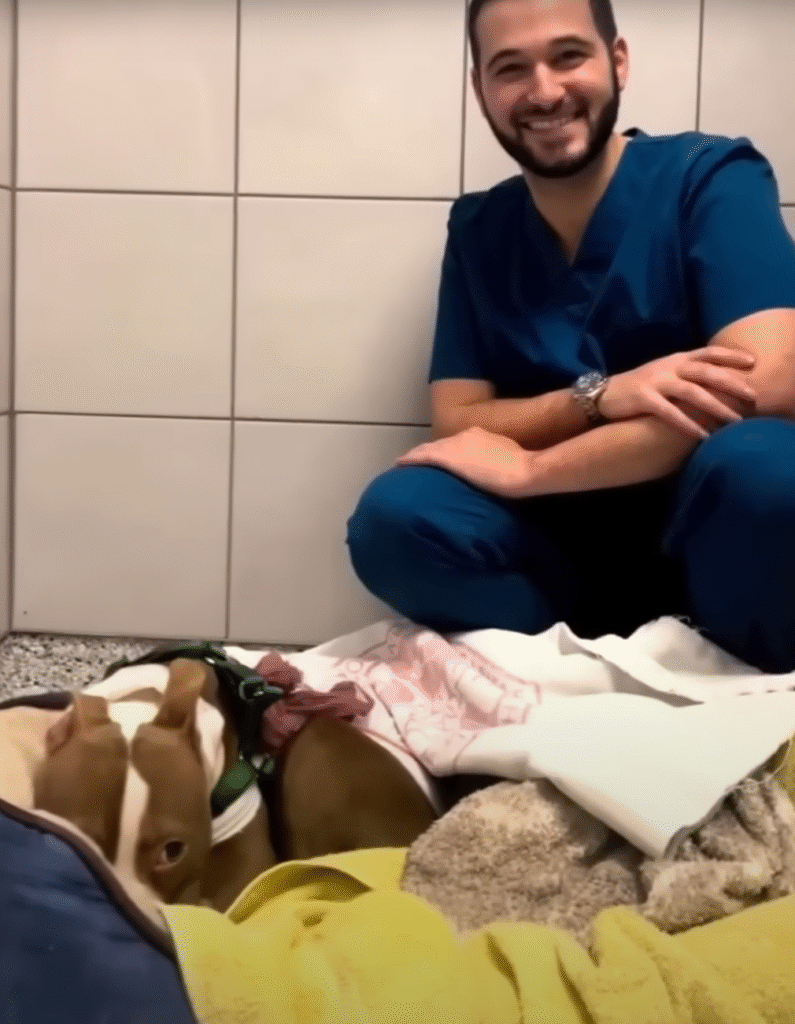
But for Dara, the most important thing wasn’t the likes or shares. It was the simple, everyday moments: Hope resting her head on her lap, Hope chasing butterflies in the yard, Hope barking at the mailman just because she finally could.
Sometimes, Dara would think back to that morning — the soft scratching at her door, the desperate eyes, the silent plea. If she hadn’t opened the door, if she’d waited a little longer, Hope might not have survived.
But she did.
And now, every time Hope wags her tail or curls up in her arms, Dara feels the quiet weight of that miracle.
Because once, Hope was a dog who couldn’t breathe or bark, with a rope embedded in her neck.
And now, she is simply Hope — alive, loved, and free.
